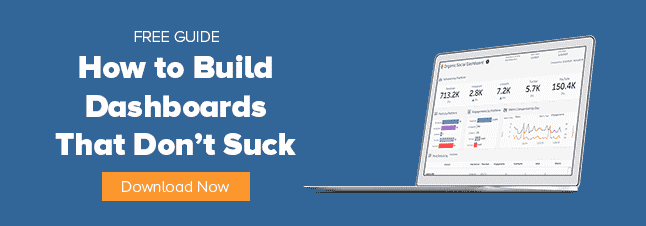
Pretty much every marketer wants to be (or thinks they already are) a data-driven marketer. But a lot of us aren’t.
Sure, we spend time — maybe a lot of time — building monthly reports on campaign performance, but we never quite have the bandwidth to analyze those results to find useful insights and recommendations, the kind that our stakeholders really want.
To understand why this happens and, more importantly, how to fix it, we have to understand the difference between exploratory analysis and explanatory analysis and the role they play in marketing analytics.
What Is Exploratory Analysis?
Exploratory analysis is just what it sounds like. You’re exploring the data to identify trends and outliers.
You might have a specific question you’re trying to answer, like which products were your top sellers last quarter. But a big part of exploratory analysis is … well, just exploring, looking to see what happened and what seems noteworthy.
A lot of marketing reporting falls under the heading of exploratory analysis. If you give a monthly update on your Google Analytics numbers, with a status check of your website’s sessions, goal completions and other KPIs, along with a list of your best-performing pages, that’s exploratory analysis.
What Is Explanatory Analysis?
Explanatory analysis is the step beyond exploratory. Instead of explaining what happened, you’re more focused on how and why it happened and what should happen next and, in most cases, communicating that to the necessary decision-makers and stakeholders.
An explanatory analysis of your Google Analytics data, for example, might include a closer look at why your top-performing pages attract so much traffic and recommendations for how they could be used to increase goal completions.
Cole Nussbaumer Knaflic, the author of “Storytelling with Data,” has a good analogy for the difference between exploratory and explanatory analysis: Exploratory is turning over 100 rocks to find one or two gems. Explanatory is showing those one or two gems to someone else.
Exploratory Analysis vs. Explanatory Analysis — Which Is Better?
A lot of marketers (and their CEOs) view explanatory analysis as being more valuable because it provides specific, actionable advice, the kind that can lead businesses to make smarter decisions about their business strategy.
While explanatory insights are valuable, you still need both types of analysis. Exploratory analysis often serves as the “Check Engine” light of marketing. All those monthly reports might feel boring and unnecessary, until they warn you that something is on fire and about to explode and, hey, are you going to do something about that?
The problem for many organizations is that exploratory analysis eats up a great deal of time. Explanatory analysis takes a backseat.
The good news is that you can fix this dynamic.
How to Find More Time for Marketing Analysis and Insight
Automated Data Aggregation
The first step is to automate your marketing data. Use a platform to automatically collect campaign data from each source system (like Google Ads or Facebook Ads) and put everything into analysis-ready datasets. We’ve seen marketers save hundreds of hours per month by doing this.
That’s because marketing data tends to be … unruly. A typical campaign might include Google Ads, Facebook Ads, your email platform, some display ads, maybe even some direct mail or traditional media.
Each of those sources has their own way of handling the same metrics, assuming they even use the same metrics. Putting all that data together in a common view, so you can compare apples to apples, is extremely time-consuming if you’re manually downloading campaign data and cutting-and-pasting it into a single spreadsheet.
(And that’s not even getting into the issue of APIs and data access, which, ugh, is a whole other problem.)
Automating your data with a dedicated platform takes that work off your desk.
Automated Reporting Dashboards
The next step is to automate your reporting. Instead of creating a spreadsheet or PDF every month, you set up a marketing dashboard.
All the data that you’ve been automatically collecting? You’re going to pipe it into the dashboard that features the standard KPIs that would normally be featured in a monthly report.
Because this process is automated, with data refreshed every day in many cases, your monthly report now becomes a “whenever my stakeholder has a question” dashboard.
You can still present a roundup of the latest numbers at the end of the month if you like (or if your boss insists) but reporting can mostly become a self-service activity.
The Benefits of Automating Data and Reporting
If you’re a marketing analyst — or someone else who’s responsible for campaign reporting — your world now looks a lot different.
You suddenly have more free time that you can use for explanatory analysis. And that analysis should become easier, too. All the data you need is available whenever you require it and updated without any effort on your part.
You can produce more useful insights and recommendations more frequently. Those recommendations make your organization more successful and efficient. Your stakeholders notice. Your team gets a larger voice in decisions (and maybe even a larger budget).
You Can Produce the Insights Your Audience Needs
Exploratory analysis is a necessary (if boring) fact of life for marketers, but automating your data and your reporting can streamline this task, giving you the time and data required to produce more valuable (and more interesting) explanatory analysis.
By shifting your approach, you can give your decision-makers the kind of insights that really do move the needle.
Automatically Collect Marketing and Sales Data from ANY Source
Alight’s end-to-end analytics solutions offer seamless data aggregation from any marketing, media and sales platform, potentially saving your team hundreds of hours. Schedule a free solution consultation with our team!

